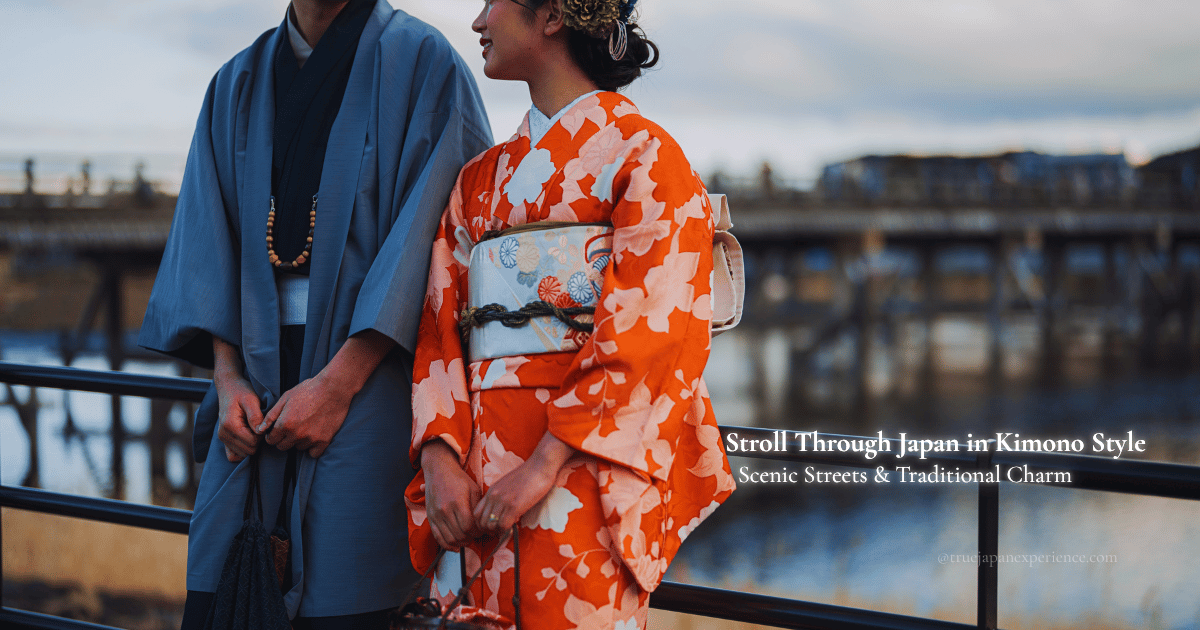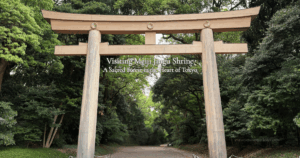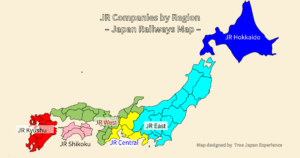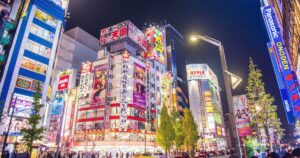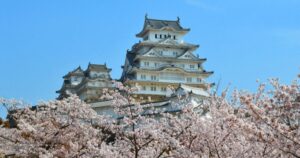Wearing a kimono and strolling through traditional Japanese streets is one of the most iconic and memorable experiences for many visitors to Japan.
It’s a way to connect with the culture, capture beautiful photos, and feel part of the country’s rich history — even just for a day.
Whether you’re walking past temples in Kyoto, exploring a castle town, or discovering hidden neighborhoods, the experience becomes even more special when done in a kimono.
In this guide, we’ll introduce the best places across Japan to enjoy this unique tradition — and where to easily rent a kimono for your adventure.
Why Kimono Experiences Are So Loved in Japan
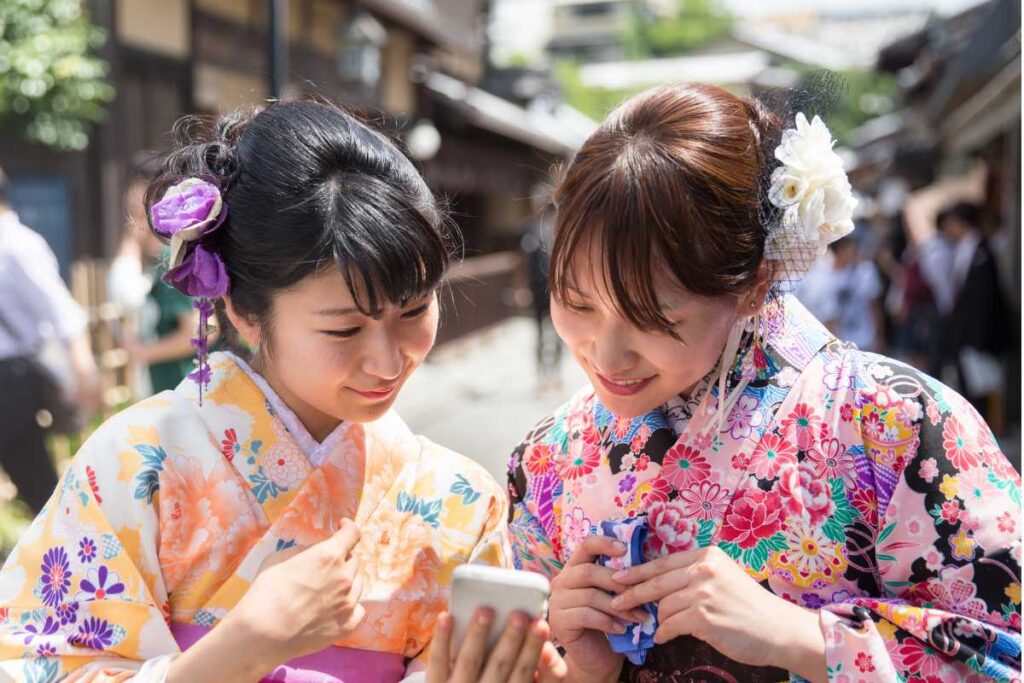
Sharing the joy — A kimono day full of smiles and memories
Trying on a kimono is more than just dressing up — it’s a cultural journey that brings visitors closer to the heart of Japan.
The experience combines beauty, elegance, and tradition in a way that few other activities can. Here are the key reasons why kimono experiences continue to captivate travelers from around the world.
Let’s take a closer look at what makes the kimono experience so special for travelers in Japan.
1. A symbol of Japanese tradition and authenticity

A peaceful moment in kimono—standing on a red bridge under golden autumn foliage
The kimono is one of the most iconic representations of Japanese culture. It has been worn for centuries — not only in everyday life of the past but also in formal events, tea ceremonies, and festivals. When travelers put on a kimono, they aren’t just trying on a costume — they’re stepping into history.
For many, it’s the first time they’ve interacted with such a deeply rooted cultural item. The process of dressing, from the underlayers to the final obi wrap, is done with care and ritual. It gives the wearer a direct experience of Japan’s values: precision, grace, and respect for tradition.
Even without prior knowledge of its history, many visitors say that wearing a kimono feels surprisingly emotional — as though they’re briefly living in a different era.
2. Timeless beauty and artistry
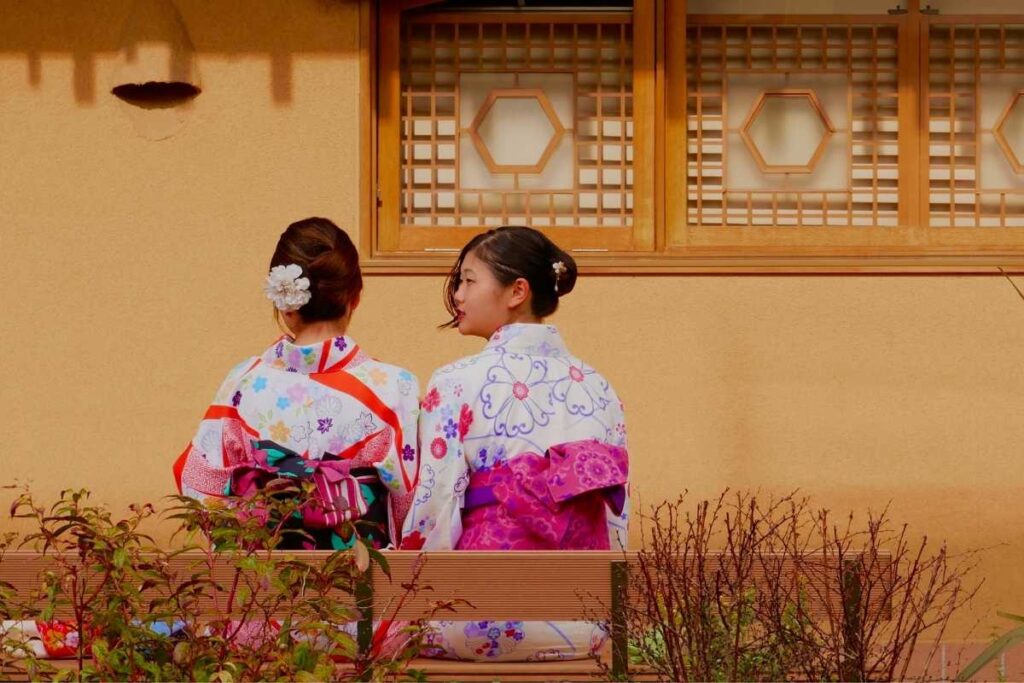
Relaxing in style — Kimono moments of grace and beauty
Each kimono is a unique piece of art. Designs often reflect seasonal motifs, such as cherry blossoms in spring or maple leaves in autumn. The fabrics, colors, and patterns are carefully chosen to express both personal and seasonal identity — something rarely seen in everyday fashion elsewhere.
Visitors are often amazed at how a single garment can carry so much meaning. Whether it’s the intricate embroidery on a formal furisode or the subtle elegance of a summer yukata, the aesthetic appeal of the kimono is immediate and powerful.
Many travelers enjoy choosing their kimono from dozens of options, matching the design with the place they’re visiting. It becomes not just a cultural activity, but a personalized experience — and one that looks stunning in photos.
3. Step into a movie or anime scene
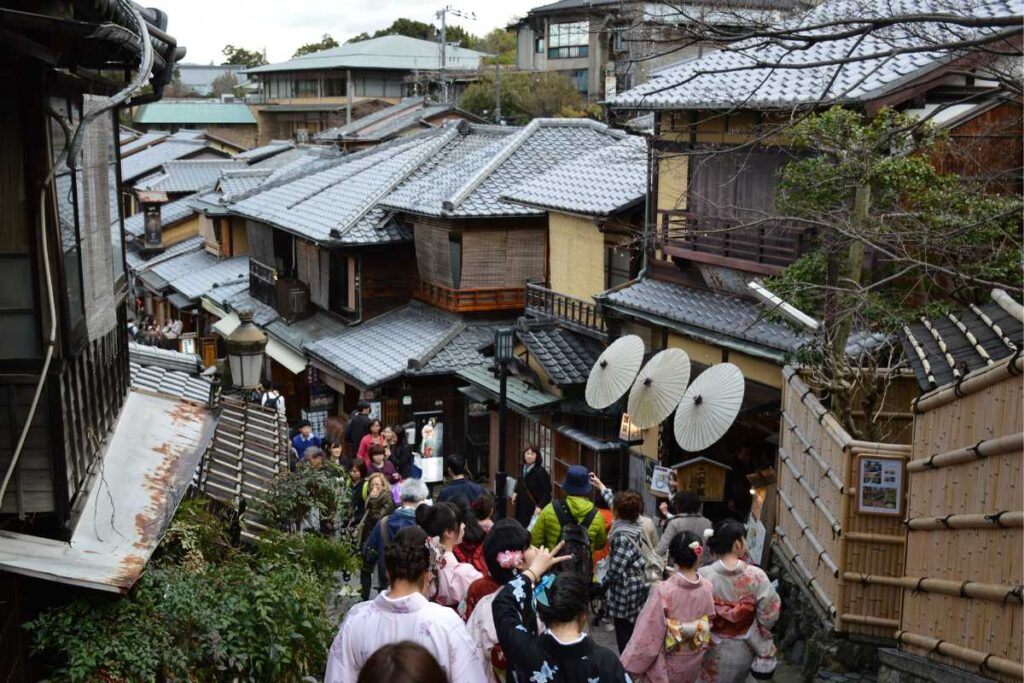
Just like a scene from your favorite anime — Kimono strolling in Ninenzaka, Kyoto
Wearing a kimono while walking through Japan’s old streets often feels like entering a different world. Places like Gion, Kawagoe, or Kanazawa can feel like a real-life movie set — and travelers become the main character.
For many, this experience is tied to memories of period dramas, historical anime, or scenes from Japanese films. The sense of nostalgia and fantasy is strong — and entirely unique to Japan.
It’s not uncommon to hear visitors say things like, “I felt like I was in Spirited Away” or “It was like being in a samurai movie.” That emotional resonance is part of why kimono walks leave such a lasting impression.
4. A graceful shift in movement and mood
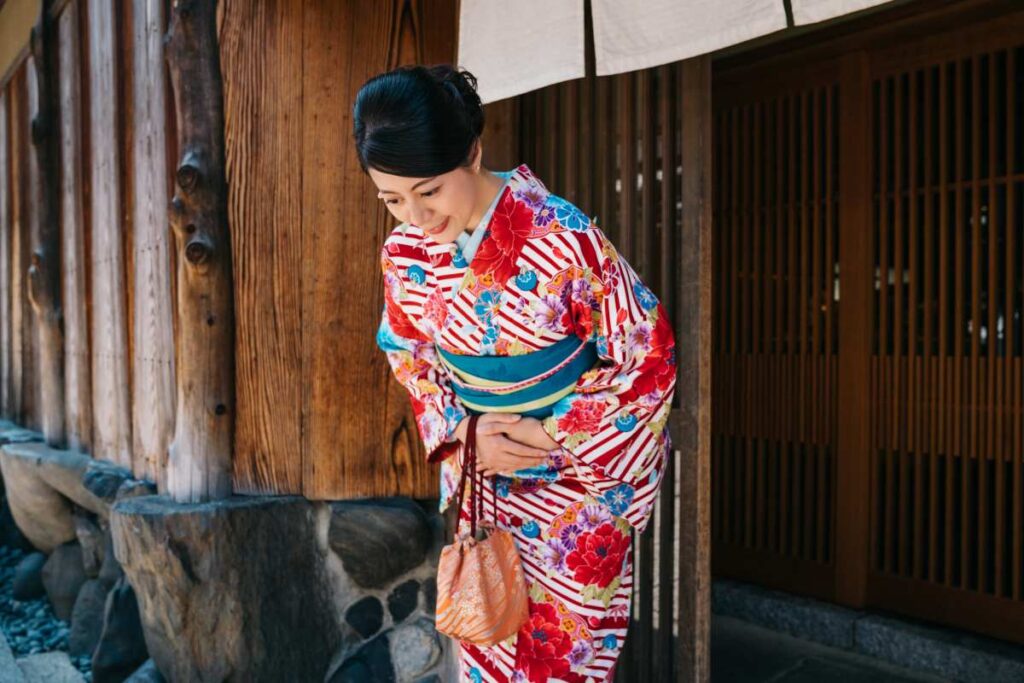
Grace in every gesture — The subtle beauty of bowing in kimono
Kimono naturally encourages slower, more mindful movement. Because of how it wraps around the body, wearers tend to take smaller, more careful steps. This changes the entire rhythm of exploration — walking becomes a graceful part of the experience.
Travelers often notice that their posture improves, and their gestures become more elegant. Some even describe a sense of calm or mindfulness that they didn’t expect.
In a world where travel often feels rushed, the act of wearing a kimono offers a rare chance to slow down, feel present, and connect with the surroundings in a new way.
5. Made for memorable photos
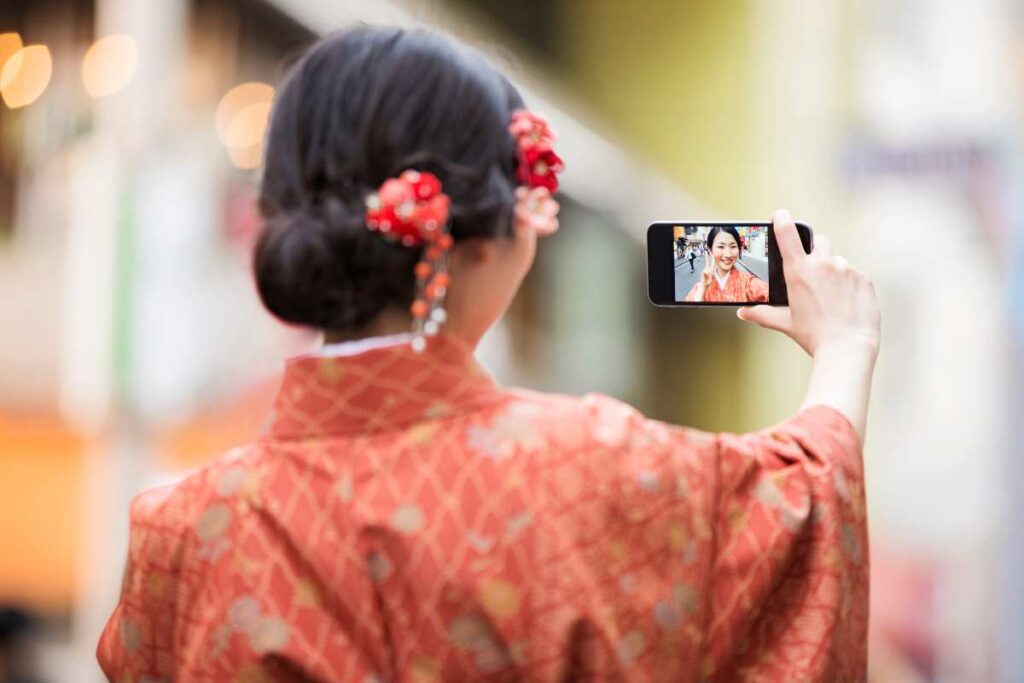
Capturing the moment — Smiling in kimono for the perfect travel memory
Let’s be honest — kimono looks amazing in photos. The vibrant colors, flowing sleeves, and detailed accessories make it incredibly photogenic. And when paired with scenic spots like temples, cherry blossoms, or historic buildings, it’s hard to take a bad shot.
That’s one reason why kimono experiences are especially popular with younger travelers and content creators. The outfits are often the highlight of their trip photos, generating buzz on social media and becoming cherished memories.
Some rental shops even offer professional photo plans, allowing visitors to walk away with high-quality images that capture the full magic of the moment.
6. A chance to learn and appreciate tradition
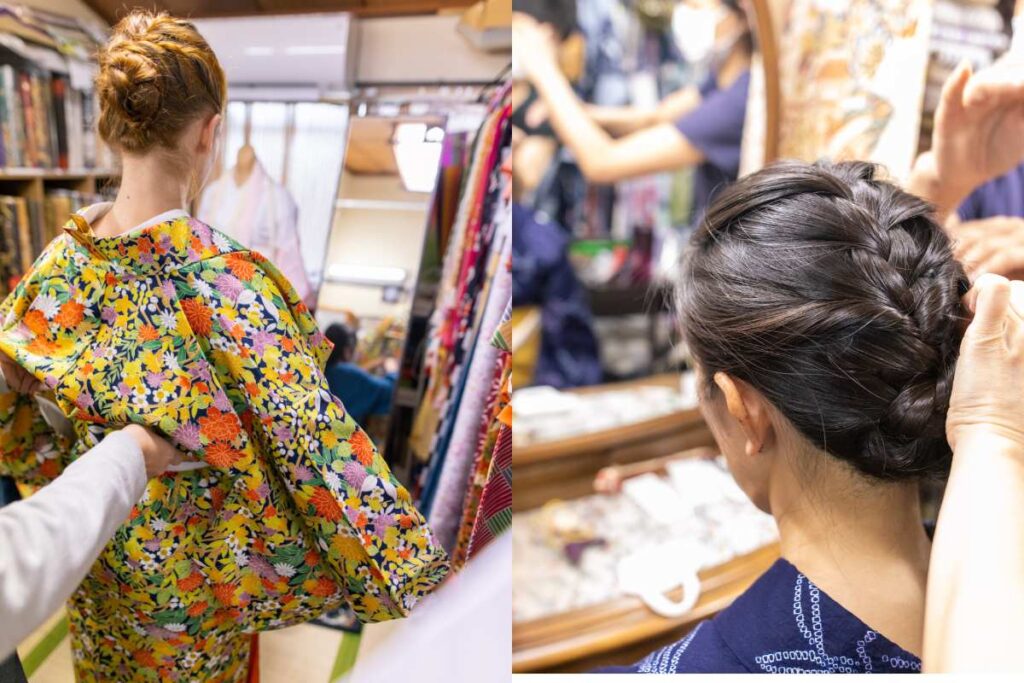
Behind the scenes — The care and technique that bring kimono to life
Many kimono rental experiences include more than just the outfit. Staff often explain the meaning behind each part of the attire — from the way the obi is tied to the seasonal designs. Some places even offer workshops on how to wear kimono or introduce the historical background of the garments.
This added layer of cultural education enriches the experience. It turns what could be a simple tourist activity into an opportunity to learn something deeply meaningful about Japanese heritage.
Visitors who join these sessions often leave with a greater appreciation not only for the beauty of kimono, but for the values and philosophy that come with it — such as seasonality, respect, and subtlety.
7. A feeling of becoming part of the culture
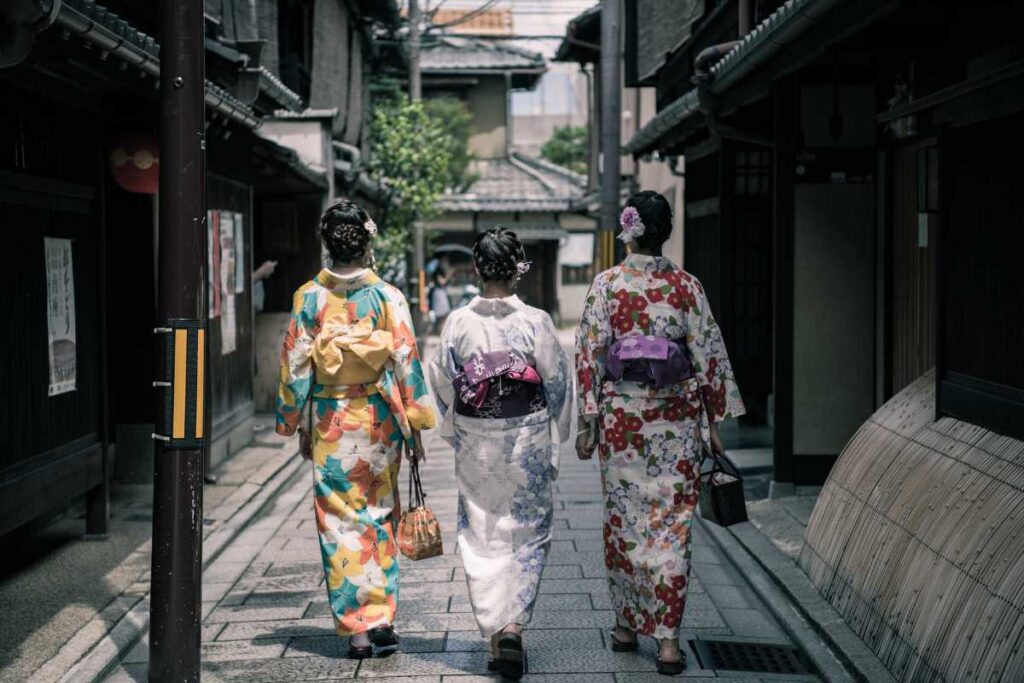
Blending into tradition — Walking through time in a kimono-clad trio
Wearing traditional clothing from another culture can be a powerful experience. It’s not about pretending to be someone else, but about momentarily stepping into another way of life.
For many visitors, wearing a kimono creates a deeper connection with Japan — beyond sightseeing. It invites interactions with locals, sparks curiosity, and leads to new kinds of conversations. Some travelers even say that they felt more welcomed or more aware of their presence in a respectful way.
Rather than watching from the sidelines, kimono wearers feel like participants in the cultural landscape. And that feeling — of being part of something bigger — stays with them long after the trip is over.
Most Popular Kimono Strolling Destinations in Japan
Some places in Japan are simply made for kimono strolls. From the cobblestone streets of Kyoto to the historic lanes of Asakusa and Kanazawa, these destinations are loved for their traditional charm, stunning backdrops, and welcoming atmosphere for kimono-wearing visitors.
Whether it’s your first time or a return visit, these are the top spots where you can enjoy the perfect combination of culture, scenery, and unforgettable photo moments.
① Kyoto – Gion, Kiyomizu, and Arashiyama
Kyoto is often the first place that comes to mind when thinking about wearing a kimono. With its historic streets, wooden townhouses, shrines, and temples, the city offers a dreamlike setting for a traditional stroll. Among the most popular areas for kimono walks are Gion, Kiyomizu, and Arashiyama — each offering a different kind of charm.
Gion and Kiyomizu are located fairly close to each other and can easily be explored on the same day. Gion is known for its geisha culture and picturesque alleys, especially Hanamikoji Street. However, due to increasing crowds and inconsiderate photography, taking photos on Hanamikoji is now prohibited — a measure to preserve the dignity and peace of the neighborhood.

The iconic Yasaka Pagoda makes a perfect backdrop for kimono photos in Kyoto’s Gion and Kiyomizu area.
If you want to take photos with traditional Japanese architecture, such as the iconic five-story pagoda near Kiyomizu-dera or the historic slopes of Ninenzaka and Sannenzaka, the Gion–Kiyomizu area is ideal. You’ll find many rental shops nearby, often with stunning seasonal kimono options.
Arashiyama, on the other hand, is farther away and better suited for a separate half-day trip. This area is famous for its lush natural surroundings, including the famous bamboo grove and the scenic Togetsukyo Bridge. If you’re dreaming of kimono photos in a peaceful setting with greenery, Arashiyama is your best bet. Rental shops in the area often offer packages tailored for exploring nature spots.
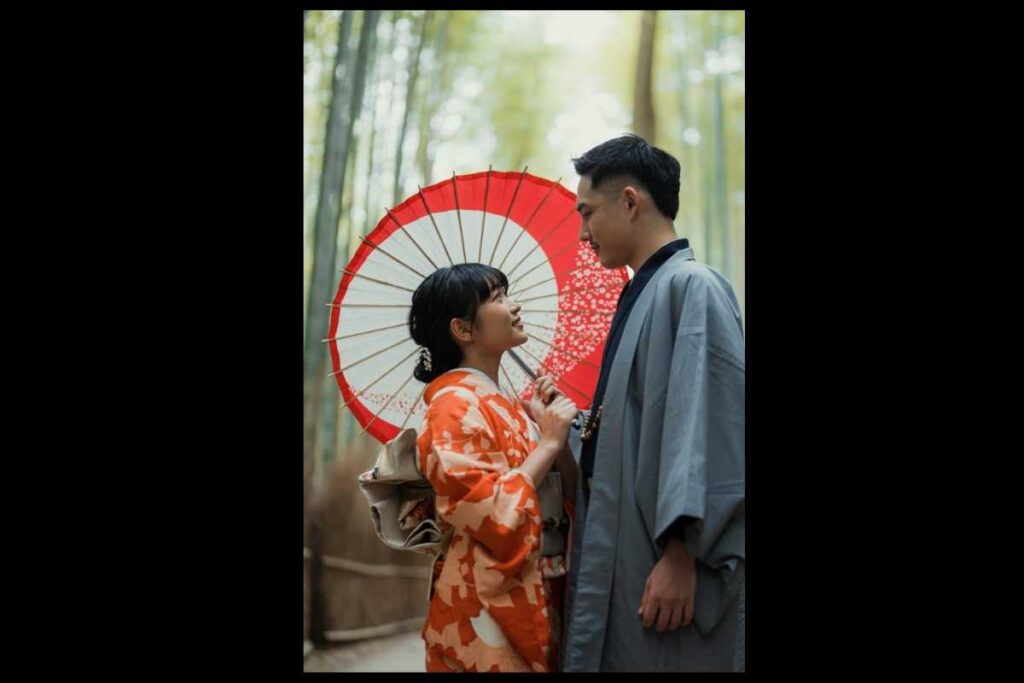
A couple strolling through the famous bamboo grove in Arashiyama — one of Kyoto’s most scenic spots for a kimono walk.
Whichever area you choose, Kyoto offers a deeply immersive kimono experience — but it’s best to focus on one side of the city to truly enjoy the atmosphere without rushing.
・Large number of rental shops, including English-speaking options
・Maiko/Geisha culture creates an authentic atmosphere
・Ideal for seasonal photos (cherry blossoms, autumn leaves)
② Tokyo – Asakusa
Asakusa is one of the few places in Tokyo where you can still feel the atmosphere of the Edo period. It blends the vibrancy of the modern city with a deep sense of tradition — making it a perfect destination for a kimono stroll.
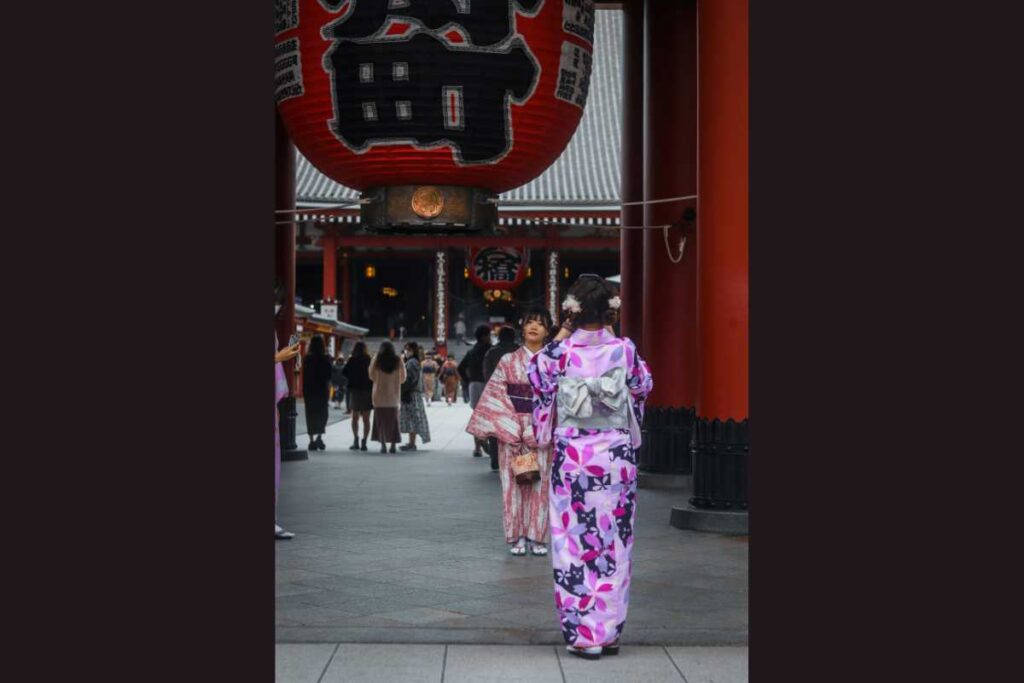
The famous lantern at Senso-ji Temple is a must-see spot for kimono photos in Asakusa.
The area is home to Senso-ji, Tokyo’s oldest temple, along with iconic landmarks like the Kaminarimon Gate and its massive red lantern, the five-story pagoda, and Nakamise Street lined with local shops and traditional snacks. These photogenic sights, combined with the timeless streetscape, make Asakusa one of the most visually satisfying places to wear a kimono.
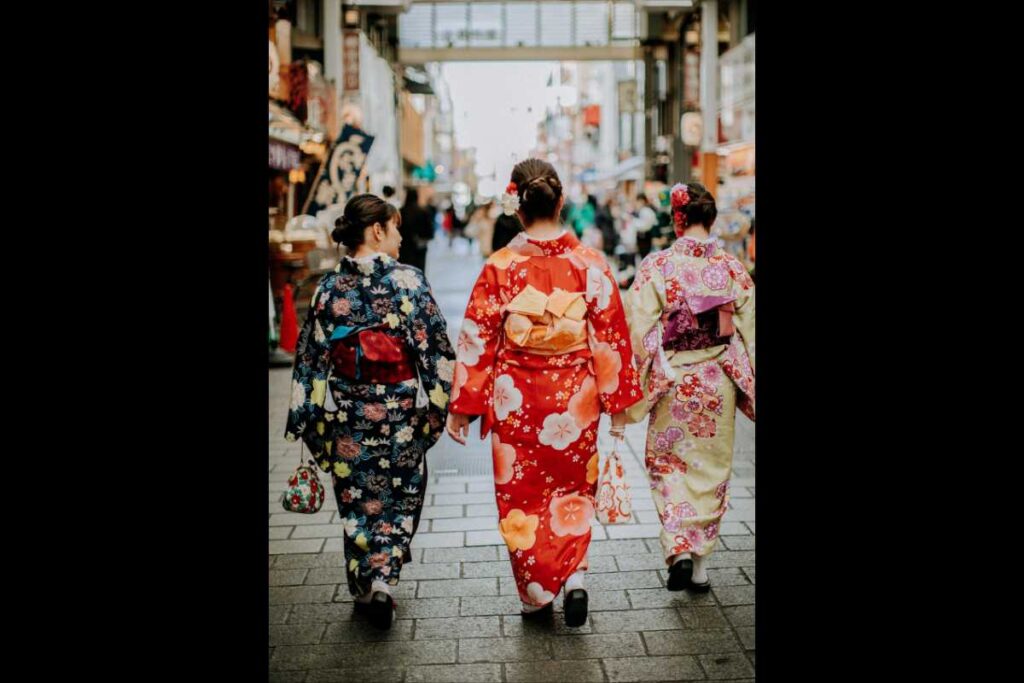
Kimono walks through old-style shopping streets are one of the most photogenic ways to explore Japan.
Kimono-clad visitors often enjoy walking along the temple grounds, pausing to take photos, or sampling street food like ningyo-yaki and matcha ice cream. Cafés, rickshaw rides, and even cruises on the Sumida River offer more ways to enjoy the area while fully dressed in traditional style.
It’s also a popular spot for social media sharing — the contrast between traditional attire and modern city energy creates a striking aesthetic that many find irresistible. For younger travelers and content creators, Asakusa is a must-visit.
The area has numerous kimono rental shops, many of which offer English-speaking staff and same-day booking. Whether you’re staying in Tokyo or visiting just for a day, it’s one of the most accessible and enjoyable places for a kimono experience.
・Excellent balance of old-town charm and modern convenience
・Iconic landmarks like Senso-ji and Kaminarimon offer ideal photo backdrops
・Popular for food strolls, rickshaws, and Instagram-worthy moments in kimono
③ Ishikawa – Kanazawa (Higashi Chaya District)

Early morning in Kanazawa’s Higashi Chaya District — a peaceful scene perfect for a kimono stroll.
Kanazawa is a beautifully preserved castle town that offers a refined and peaceful setting for a kimono stroll.
As the former seat of the powerful Kaga Domain, the city still carries the elegance and cultural richness of its feudal past. This atmosphere is especially strong in areas like Higashi Chaya District and Nagamachi Samurai Residence Area, where traditional architecture from the Edo period remains largely intact.
Higashi Chaya is lined with stone-paved lanes, lattice-fronted wooden townhouses, and teahouses that once hosted geisha. The entire district exudes a quiet elegance that perfectly complements the refined beauty of a kimono.

Walking through Kanazawa’s historic teahouse district in kimono offers a refined, quiet beauty unique to the city.
Popular photo spots include the historic “Shima” teahouse — a nationally designated Important Cultural Property — and various picturesque alleys framed by wooden facades and hanging lanterns.
One of Kanazawa’s unique appeals is the variety and quality of kimono available. You can rent Kaga Yuzen kimono, a traditional hand-dyed silk style known for its graceful motifs and seasonal designs, or choose from vintage and antique kimono that reflect the city’s deep cultural roots.
Beyond tradition, Kanazawa is also known for its modern touches. You’ll find stylish cafés, craft boutiques, and art spots like the 21st Century Museum of Contemporary Art, making it easy to enjoy a blend of old and new while exploring in kimono.
・Peaceful, elegant streetscapes ideal for slow kimono walks
・Variety of high-quality kimono styles, including Kaga Yuzen and vintage pieces
・Cultural mix of historic teahouses and modern cafés enhances the experience
Emerging Kimono Walking Spots You Shouldn’t Miss
While Kyoto and Asakusa are well-known favorites, there are other towns across Japan that offer equally enchanting — and often less crowded — experiences for walking in kimono.
These up-and-coming destinations are rich in history, charm, and photo-worthy backdrops, yet still feel like hidden gems to many travelers.
If you’re looking to explore beyond the usual spots and discover somewhere truly memorable, these places are well worth adding to your itinerary.
(1)Aichi – Inuyama Castle Town
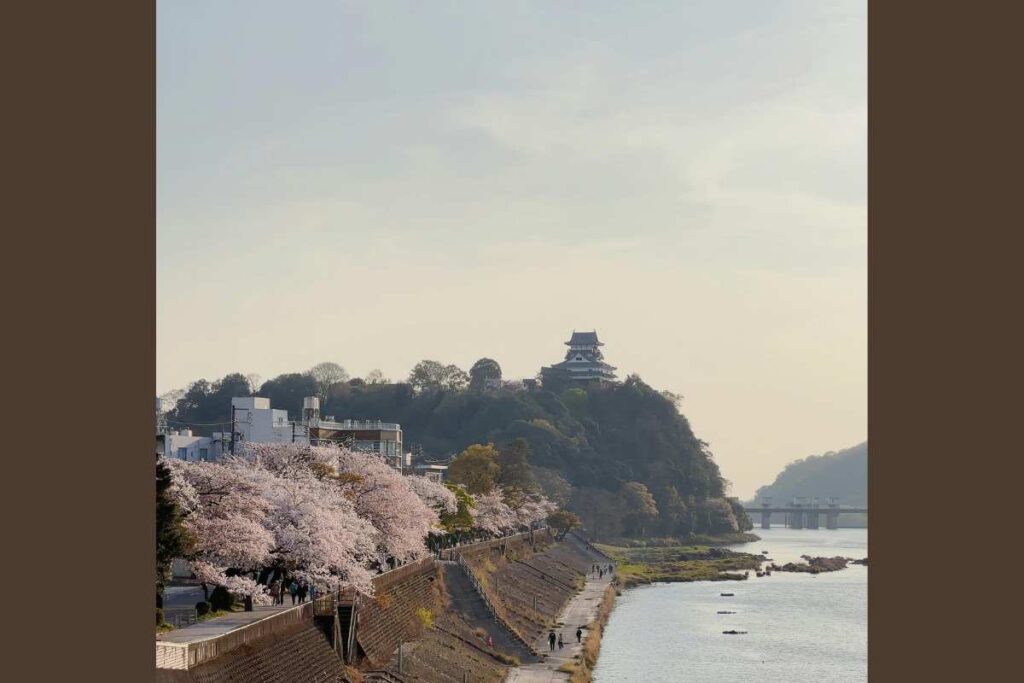
Inuyama Castle offers breathtaking seasonal views — especially during cherry blossom season along the Kiso River.
Inuyama is a charming castle town where history truly comes alive. Its most iconic feature is Inuyama Castle, Japan’s oldest surviving wooden keep and a designated National Treasure.
The castle overlooks a well-preserved district of Edo-period streets, creating a rare setting where visitors can walk through time — especially when wearing a kimono.
The area surrounding the castle is lined with traditional wooden merchant houses now operating as cafés, craft shops, and souvenir stores.
These nostalgic streetscapes make it a perfect place for kimono photography and leisurely strolls. The contrast of a vibrant kimono against white plaster walls and wooden lattices is uniquely picturesque.
Inuyama is also home to Inuyama Festival, a UNESCO-recognized intangible cultural heritage event. During the festival, the town comes alive with colorful floats and music, and many visitors wear kimono to match the festive mood.
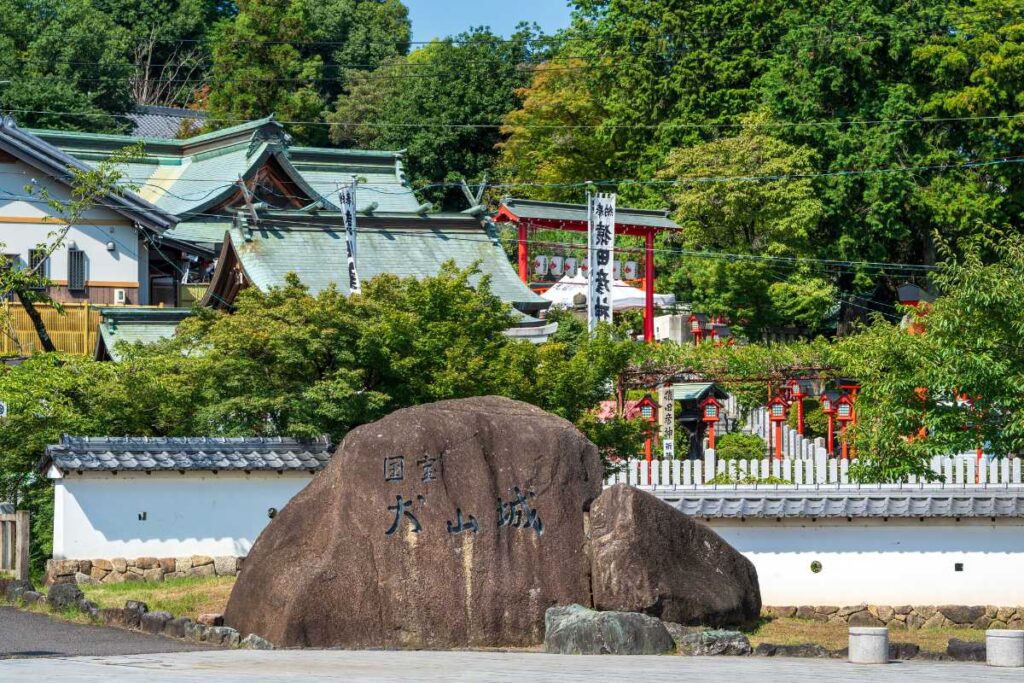
The entrance to Inuyama Castle features traditional landmarks like torii gates and shrines, adding to its cultural charm.
Another unique point: Inuyama offers the rare chance to take kimono photos with a real, original Japanese castle as your backdrop. Unlike Nagoya Castle, which was rebuilt with modern materials after wartime destruction, Inuyama Castle retains its original wooden architecture — giving it a much more authentic and atmospheric presence. If you’re seeking a truly historical setting, Inuyama is the place to go.
・Stunning photo opportunities with Japan’s oldest original castle
・Charming Edo-style townscape perfect for strolling and shopping
・Seasonal festivals and temple visits enhance the cultural experience
(2)Saitama – Kawagoe
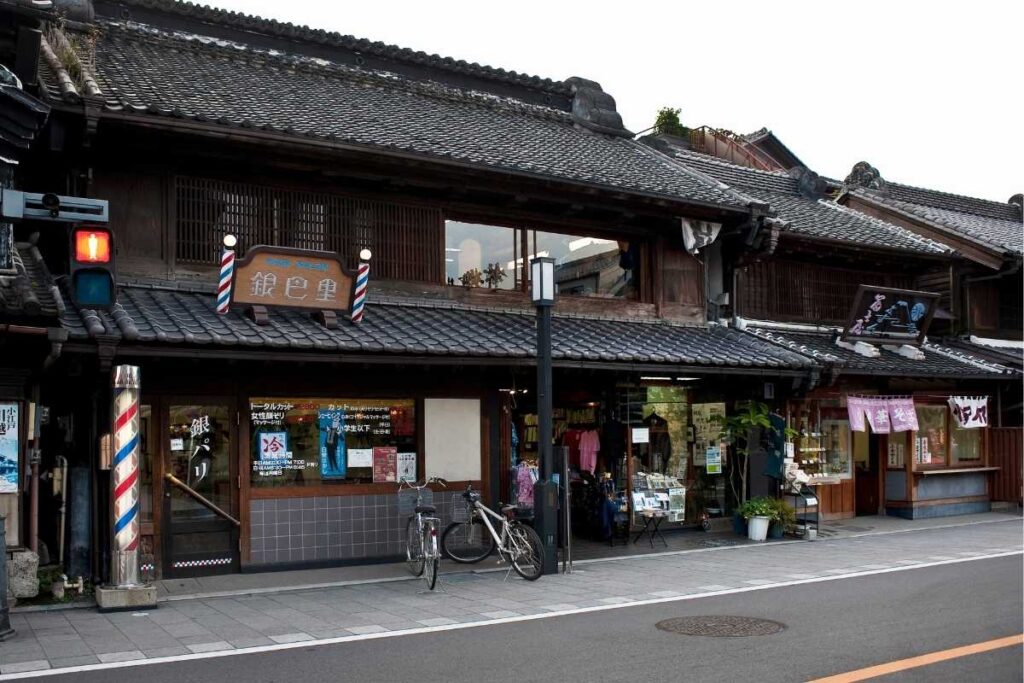
Kawagoe’s preserved merchant streets blend Edo-period charm with local shops and cafés — perfect for a kimono stroll.
Often nicknamed “Little Edo,” Kawagoe flourished as a castle town during the Edo period, and its historical charm is still very much alive today.
The town is known for its kurazukuri warehouse-style buildings, black-plastered walls, and grand ceramic roof tiles — all of which create an atmospheric backdrop that pairs beautifully with traditional kimono.
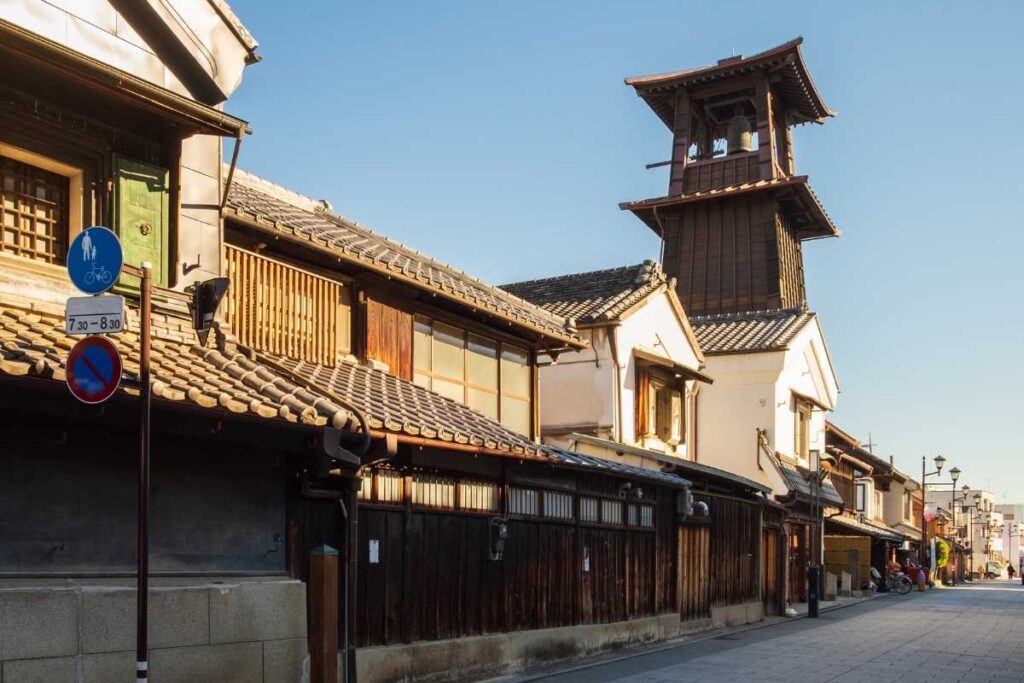
The Toki no Kane bell tower is Kawagoe’s most famous landmark — and a must-see spot for kimono photos.
One of the most iconic sights is the Toki no Kane (Bell of Time), a wooden clock tower that has become a symbol of Kawagoe. Nearby, Kashiya Yokocho (Penny Candy Alley) adds a playful, nostalgic touch, especially for visitors dressed in colorful kimono. These spots are not only historically significant but also popular for photo opportunities.
What makes Kawagoe particularly special is the blend of eras. In addition to its Edo-style streets, the area includes Taisho Roman Yume Street, which features early 20th-century architecture with Western influences.
Walking through the area in kimono allows you to enjoy a mix of Japanese and Western retro aesthetics in one compact, walkable district.
The town is also dotted with cafés, traditional sweets shops, and artisan boutiques housed in old buildings. Many visitors enjoy strolling, snacking, and shopping — all while dressed in elegant kimono, making for a relaxed yet richly cultural outing.
Kawagoe is easy to access from central Tokyo via Kawagoe Station or Hon-Kawagoe Station, and the main sightseeing area is close enough to explore on foot without the need for public transport.
・Richly preserved Edo-period streets with elegant kurazukuri architecture
・Photogenic highlights like the Bell of Time and retro shopping alleys
・Compact, walkable area perfect for slow strolling, café hopping, and kimono photos
(3)Toyama – Uchikawa
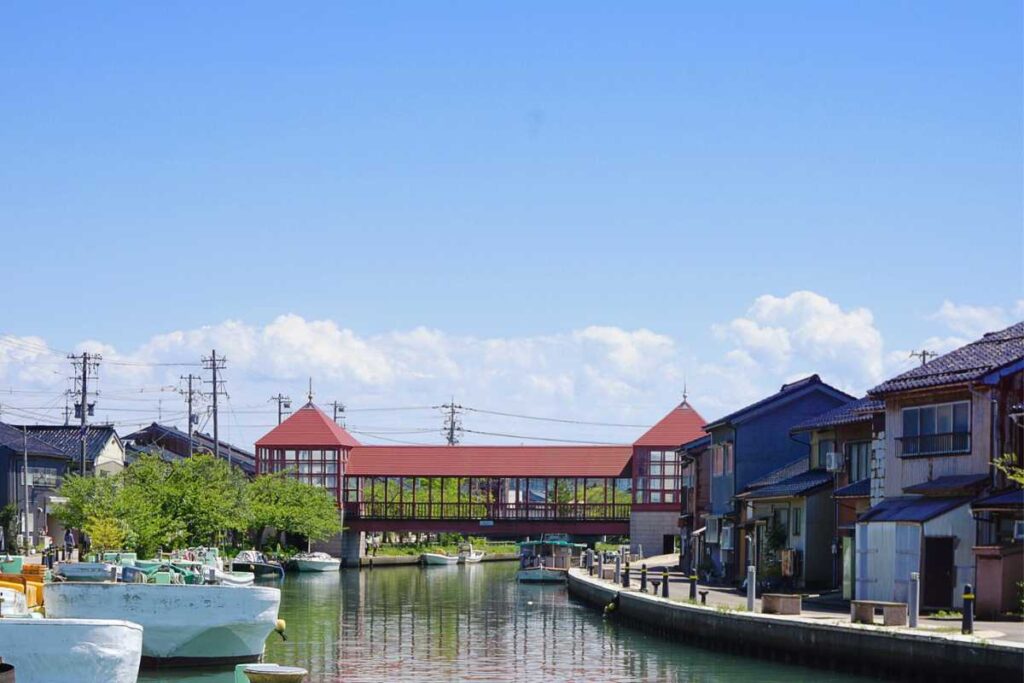
Uchikawa’s quiet charm and riverside streets make it a perfect setting for a kimono stroll, away from the crowds.
Located in Imizu City, Toyama Prefecture, Uchikawa is a peaceful canal town often referred to as “the Venice of Japan.”
Here, rows of fishing boats line both sides of the canal, and traditional wooden homes stretch along the waterfront, creating a quiet, nostalgic scene that feels worlds away from Japan’s busy cities.
Wearing a kimono while strolling along Uchikawa’s stone-paved paths allows you to enjoy its distinctive waterside charm.
The area features a dozen unique bridges — including sculpted stone bridges and one with striking red gabled roofs — each offering excellent photo opportunities. With every step, the view changes subtly, revealing moments that are both tranquil and deeply Japanese.
Much of the town still retains the atmosphere of early 20th-century Japan. Old wooden houses, storehouses, and remnants of boatyards offer a glimpse into everyday life from a bygone era.
The combination of retro townscape and traditional kimono creates a perfect setting for warm, nostalgic photography.
The town is compact, so it’s easy to explore on foot, and its small scale fosters close, friendly interactions with locals.
Unlike major tourist hubs like Kyoto or Kanazawa, Uchikawa remains quiet and serene. If you’re seeking a peaceful, crowd-free place to enjoy Japan’s beauty in a kimono, this hidden gem is ideal.
・Charming retro canal town perfect for slow kimono strolls
・Bridges and waterfront views offer truly unique photo spots
・Close connection to local life offers an authentic, small-town experience
Final Thoughts: Let the Streets Become Part of Your Kimono Story
After exploring famous cultural hubs like Kyoto and Tokyo, or discovering hidden gems like Uchikawa and Inuyama, you’ll find that walking through Japan in a kimono isn’t just about sightseeing — it’s about becoming part of the scenery itself.
Whether you’re drawn to elegant townscapes, riverside charm, or historic castle streets, the experience of wearing a kimono in the right place can turn an ordinary trip into a memory of a lifetime.
So choose your favorite spot, take your time, and enjoy the feeling of tradition at your own pace.
Curious about how kimono rental works, what to wear underneath, or how to walk gracefully in it?
We’ve got you covered in this detailed guide:
Kimono Rental in Japan: How to Enjoy the Experience and Understand Its Meaning
